Since relatively recently, a rather unusual tool has appeared in Windows-systems, which allows to determine the so-called performance index, which characterizes the speed of the installed OS and all the hardware or virtual devices present. But it is unlikely that an ordinary user will be able to use such an assessment of the performance of a computer with Windows 7 or with systems on board of a rank higher than that to improve system performance, but for many experienced users it can give a lot of reasons for reflection. Nevertheless, we will try to consider solutions that will really allow any computer to work much faster than using the default operating system settings. For the most part, we will focus mainly on the system tools, and third-party tools, although they seem to many to be much more effective, will be presented only as alternative solutions for understanding the big picture, because at the right time they may not be at hand.
Performance assessment of a Windows 7 computer: what is it and why is such information needed?
So what is meant by such an index? In fact, according to the vast majority of experts, such information is very conditional, since the output of ever newer, more powerful and constantly improving computer configurations negates all estimates in terms of objectivity. In the list of evaluation results you can find information related to the processor, RAM, hard disk, graphics processing, etc. But many users are often perplexed that the performance index for a powerful configuration is, to put it mildly, excessively underestimated. This is due only to the fact that the total score (not even averaged, as one might expect) is set exclusively by the weakest indicator after testing each individual computer component. And that is why the attitude of such information on the part of experts seems very skeptical.
How to see the performance of a computer with Windows 7?
However, for starters, let's still discuss how to view the necessary data regarding the overall performance assessment of a computer system.
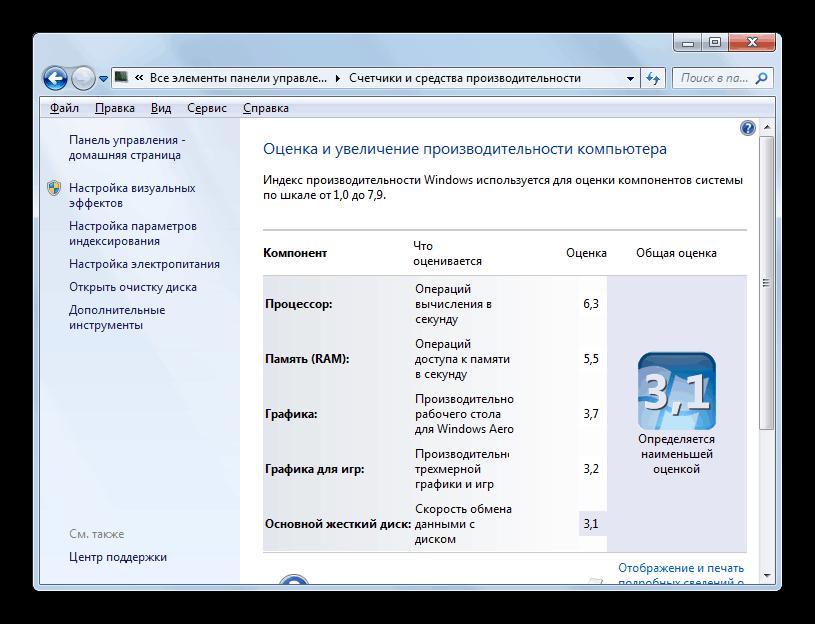
To check the performance of a computer with Windows 7 on board, you need to use the counters and productivity tools section, which is located in the standard "Control Panel". Do not be surprised if the overall index is lower than what you expected to see. This is a normal phenomenon, because even when using the standard system parameters after the first installation of Windows, too many components and services can be activated in the system itself, which are not only not needed by the user in everyday work, but can also very heavily load the resources of any, even the most powerful PC or laptop. By and large, such an assessment should not be paid special attention, but some actions that will help to maximize the performance of your Windows 7 computer will still have to be performed. The solutions proposed below can equally be applied to all subsequent releases and assemblies, since basically they are almost completely identical to each other (with the exception of some minor parameters and settings).
Key actions to increase productivity
So, how to improve computer performance on Windows 7 or on later systems? To do this, follow these steps:
- deactivation of too "gluttonous" elements of the graphical interface;
- Disabling unnecessary startup items starting with the OS;
- shutdown of unused and resource-loading system components and services;
- optimal setting of the applied power scheme;
- maximum use of processor cores;
- keeping device drivers up to date;
- Correct use of virtual memory by adjusting the page file settings;
- timely maintenance of the hard drive, etc.
Of course, you can bring a lot of additional aspects, but for now let's dwell on those that are presented in the main list.
Interface setup
Let's start with the simplest. Apparently, there is no need to say that in the interface of the seventh modification of Windows the maximum possible number of peculiar “decorations” was applied, because the default theme is Aero with its rounded and translucent panels, all kinds of smooth transition effects, etc. For some reason ordinary users never really think about the fact that all these effects have a significant enough impact on the use of resources of the graphics accelerator, which is responsible for visualization, and if there is an integra RAM cards can also partially be used. Because of this, when starting resource-intensive games, FPS may slow down or decrease, because the adapter is simply not able to process such a huge amount of information. The same may apply to some multimedia processing programs. In particular, a very significant decrease in performance is noticed when working with video. Thus, when considering how to improve the performance of a computer on Windows 7 or any other similar OS, the answer suggests itself: all this unnecessary decoration should be turned off.
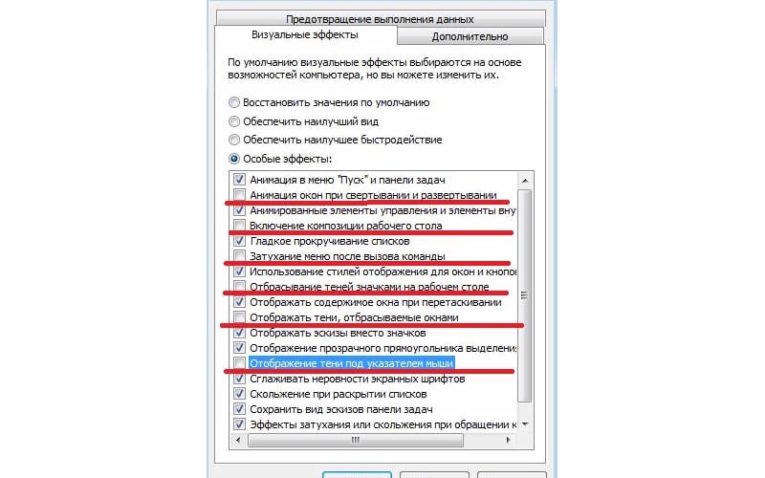
To do this, in the simplest version, you can use the system properties section, called via PCM on the computer icon on the "Desktop" or in "Explorer", go to additional settings, click the speed options button and select the option to ensure the best performance instead of the best view that is activated default. Naturally, after applying such changes, the system will become a little similar to outdated versions of Windows, but you can choose not to disable everything in the list, but leave some important options, for example, responsible for smoothing screen fonts.
Startup check
Auto start elements also load the system, since processes loaded with Windows, which are constantly hanging dead load, can use RAM quite heavily. In addition, if there are a lot of them in the startup list, the start of the system, as you probably already understand, will take much longer. How to increase the performance assessment of a computer with Windows 7 by deactivating such elements? This can be done by using the standard configuration tool, which can be called through the "Run" console with the msconfig command.
On the startup tab, you must disable everything that is there. It is recommended to leave only the standard anti-virus module, as well as the ctfmon service, which is responsible for the correct operation of the language panel and switching languages with the corresponding layouts.
Unfortunately, the standard list does not display a complete list of automatically launched services, and the launch of some of them can be registered, for example, in the same "Task Scheduler". To configure all the elements of the auto start as finely as possible, it is better to use the notorious CCleaner program, which will show absolutely all startup components.
Disabling unnecessary system components
If you ask users how to increase the performance rating of a computer with Windows 7, many for some reason immediately recall the hardware, not the software environment. In Windows, so much of everything superfluous is initially activated that you are simply amazed. It is clear that the developers tried to take into account all possible situations, but some components are simply not needed by ordinary users. For the sake of interest, go through the "Control Panel" to the section of programs and components and go to the item on and off the system components.
In the list provided, you can completely deactivate print services if you do not have a printer. If you do not use virtual machines, feel free to turn off the Hyper-V module. If you prefer third-party browsers to Internet Explorer, deactivate it as well. In general, there are a lot of options.
Power Options
Now a few words about how to properly configure the power supply and how to improve the performance of a computer with Windows 7 for games. Two options for configuring circuits (from the network and from the battery) are present only on laptops, and there is no special game mode that appeared in the tenth modification of the system in the seventh version.
For maximum performance when playing modern games with their textures and high FPS, set a high-performance scheme, not a balanced one. But at the same time, it is worth remembering that when working, for example, with office programs, you will have to switch to normal or economical mode manually, because in the seventh modification automation is simply not provided. But when using a high-performance circuit, the system itself will turn off all unnecessary processes, allocating maximum resources exclusively for the running application.
Do I need to use all the processor cores?
Sometimes you may come up with questions about whether it is possible to improve the performance of a computer on Windows 7 by including all the processor cores. I must say that many experts call such actions very controversial, since one incorrect action can lead to a complete failure of the entire system. Nevertheless, it is recognized by all that absolutely all CPU power is never used. And if such a need is brewing, you can change some important parameters, but keep in mind that you will have to perform such actions at your own peril and risk.
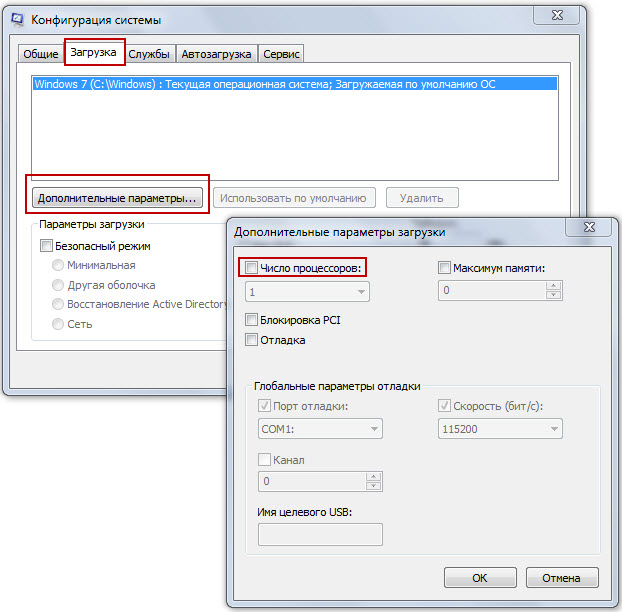
First, go to the configurator (msconfig), then on the download tab, click the button for additional parameters, in the new window, select the option to install the maximum number of processors, and select the highest value from the drop-down list. You do not need to specify a maximum of RAM, however, if you decide to take this step as well, you need to set the value based on the total volume, but not less than 1024 MB for each core. Before setting such parameters, it is better to read the technical documentation for your computer or visit the processor manufacturer's website for more information on the safe use of all cores.
Deactivating Unnecessary Services
Now let's see how to improve the performance of a Windows 7 computer by disabling unnecessary services, some of which have already been deactivated in the startup section and in the list of system components. Access to the management of services is done from the "Run" menu with the services.msc command. There will be too much confusion in the list presented, however, some elements can be selected.
So, you can completely disable the Superfetch service, the print service, if it has not been disabled before, and much more. Just sort the services by state and look at the ones that are running.
Often, some users try to improve the performance of a computer with Windows 7 by disabling automatic updates, but this can also be called a very controversial issue. Yes, of course, among the update packages for the Seven you can find unfinished or malfunctioning solutions, but deactivating the installation of updates completely and completely is not recommended. For that matter, it’s better to set up a delayed installation or use the options to indicate the installation time - the period of inactivity when you are not working at the computer.
Driver update
It is impossible to imagine an increase in the performance of a computer with Windows 7 on board or with any other similar OS without keeping the drivers up to date. Here you need to understand that the updated control software just allows you to free up all hidden resources or potential inherent in the equipment to the full. Performance tuning of a computer with Windows 7 in this case comes down to a timely update of drivers. You don’t really need to rely on the means of Windows systems themselves, since they will install drivers from their own databases, and an automatic update mode is not provided for this at all (unless some drivers will be contained in update packages for the system itself). In this case, it is advisable to keep programs on the computer like Driver Booster, which, constantly working in the background, will monitor the output of the updated software, and then install it either automatically or in consultation with the user. True, the presence of a constantly active Internet connection in this case is a prerequisite.
Page File Actions
Now we’ll look at how to increase the performance of a Windows 7 computer by performing some actions with the virtual memory settings, for which the so-called page file (pagefile.sys) is responsible. Why, in fact, is it needed? The system initially reserves some space on the hard drive, and in case of a lack of RAM, it unloads the components of active programs to the hard drive. But the speed of accessing the hard drive is several times lower than that of RAM! On the one hand, this approach allows you to partially offload the RAM, but if you reserve too much space on the hard drive, the opposite situation can also be observed when the operating system starts to ignore RAM and uses just the hard disk space as a priority access, which even starts computer braking. In this situation, trusting the default Windows settings is not always advisable. So, many experts in the field of optimizing Windows-systems recommend using the virtual memory to disable completely. Typically, such advice applies to cases where the computer has about 8 GB of RAM or more, however, if you work only with office applications and do not handle multimedia or do not play games, you can turn off the use of virtual memory even with RAM volumes at level 2 GB The increase in performance will be noticeable immediately after disabling the swap file and rebooting the system.

To perform such actions, it is necessary to use additional system parameters, as described for visual effects, but to access the virtual memory settings, you must click the paging file resize button on the additional options tab. First, the item for automatic size selection by the system is disabled (and for each of the available partitions), and then the item that disables the use of virtual memory is marked. After saving the installed options, restarting the computer system is mandatory.
Disk maintenance
Finally, it is worthwhile to dwell on how to improve the performance of a Windows 7 computer in terms of providing faster access to the hard disk and freeing up free space. Let's start with the second paragraph. If anyone does not know, for the normal operation of any of the latest modifications of Windows in the system partition, at least 10-15% of the total space should remain free. This is an axiom! But how and due to what to free up additional free space?
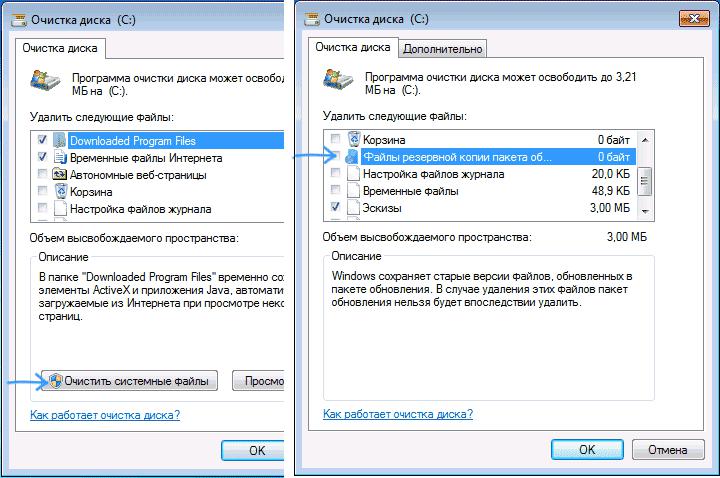
To do this, you can use at least standard disk cleanup, simultaneously involving the removal of system files, and then marking in the list all the components that will be found. In this way, you can even get rid of old service packs or files from previous assemblies. Also, do not forget that you can remove unused or rarely used programs. To remove even applications embedded in the system, you can use special uninstallers like iObit Uninstaller, which not only uninstall the main ones, but also clean up the residual elements of remote applications without user intervention.
, . hyberfil.sys, . , , «powercfg –h off» ( ), . , , .
, Windows 7, , , - . , . But how to do that?
, (, iObit SmartDefrag), , .
In conclusion, we will see how to check the performance of a computer with Windows 7, and at the same time achieve the maximum increase in system performance with a minimum of costs. For such purposes, a lot of utilities have been developed to date. The most high-quality, according to most users and experts, are such well-known programs as CCleaner, Advanced SystemCare, AVZ, Windows 7 Manager and many others. Their advantage lies not only in the complete automation of processes, but also in the fact that most of these applications allow you to easily tidy up the system registry by removing obsolete or incorrect keys from it, which speeds up the loading of the OS quite a lot (scanning starts with any Windows registry, and the more entries in it, the longer it takes to perform such actions). In addition, such programs constantly monitor the state of the computer, allowing you to automatically or on demand optimize certain parameters, including even unloading unnecessary program components from RAM. How to speed up computer performance in Windows 7 with their help?
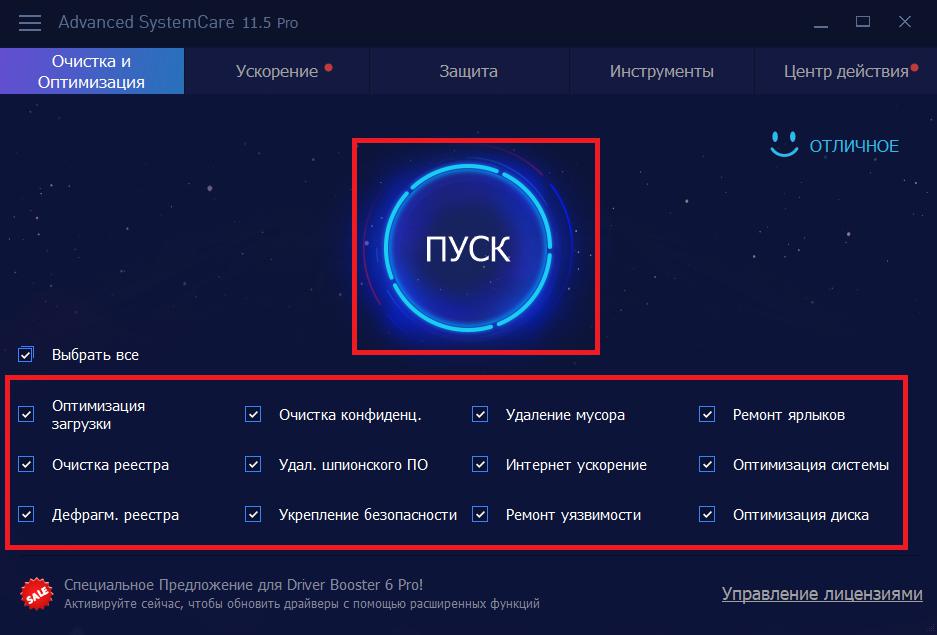
To do this, most utilities have a special mode of complex optimization, when using which you should only mark the necessary modules, and then scan for any problems with their subsequent automatic elimination. By the way, many programs of this class allow you to perform the settings described above for managing services and system components, but in a much wider range than using standard Windows tools, and at the same time checking your computer for viruses, potentially dangerous or unwanted software.